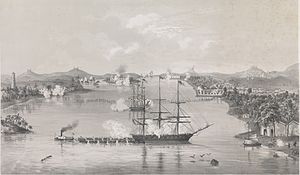Battle of the Pearl Forts
| Battle of the Barrier Forts | |||||||
|---|---|---|---|---|---|---|---|
| Part of the Second Opium War | |||||||
 Attack on the Barrier Forts on November 21, showing Portsmouth, Levant, and the steam frigate San Jacinto |
|||||||
|
|||||||
| Belligerents | |||||||
|
|
|
||||||
| Commanders and leaders | |||||||
|
|
|
||||||
| Strength | |||||||
|
Land: 50 marines 237 sailors Sea: 2 sloops-of-war 1 frigate |
5,000 garrison troops 3,000 non-garrison troops |
||||||
| Casualties and losses | |||||||
| 10 killed 22 wounded |
250–500 killed or wounded 176 guns captured |
||||||
The Battle of the Barrier Forts (also known as the Battle of the Pearl River Forts) was fought between American and Chinese forces in the Pearl River, Guangdong, China in November 1856 during the Second Opium War. The United States Navy launched an amphibious assault against a series of four forts known as the Barrier Forts near the city of Canton (modern-day Guangzhou). It was considered an important battle by the British whose interest lay in capturing Canton.
Sailing off the Chinese coast, USS Portsmouth and USS Levant had received news of the beginning of the Second Opium War. The two sloops-of-war were tasked with protecting American lives by landing a 150-man detachment of marines and sailors in Canton.
After a peaceful landing the Americans occupied the ancient city. Commanded by both Commodore James Armstrong and Captain Henry H. Bell, USS San Jacinto arrived in Canton's harbor and learned of the occupation. San Jacinto then landed a shore party of her own.
On November 15, 1856, after a brief stay and no military contact, the force withdrew from the city. During the withdrawal, Commander Andrew H. Foote of the Portsmouth rowed out to his ship. As he rowed past the Pearl River Forts, the Chinese garrison fired on the small American boat a few times but the withdrawal continued.
The next day the U.S. seamen had constructed a plan to attack Canton's citadels in retaliation for the Chinese attack on Commander Foote.
Now a force of one steam frigate and two sloops-of-war, the naval squadron under James Armstrong made their way up the Pearl River and launched an attack on Canton's coastal forts. USS Portsmouth closed in on the nearest of the four citadels and fired the initial salvo on November 16.
...
Wikipedia
